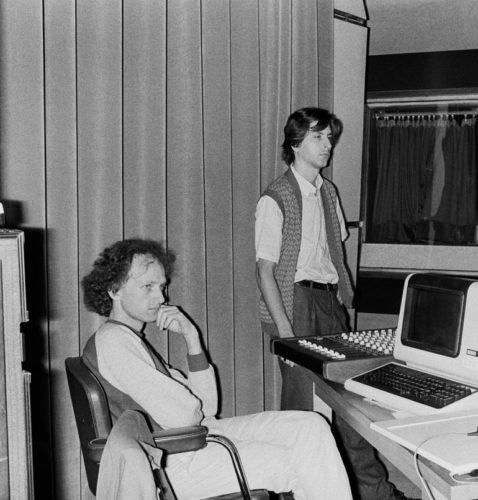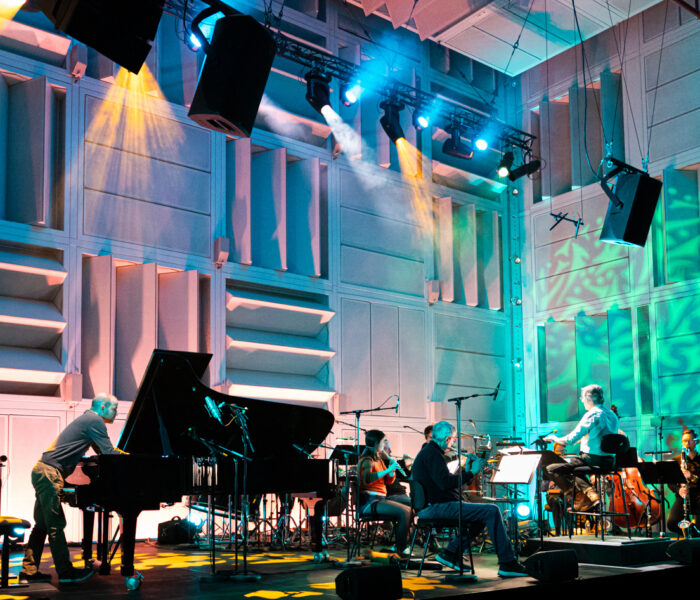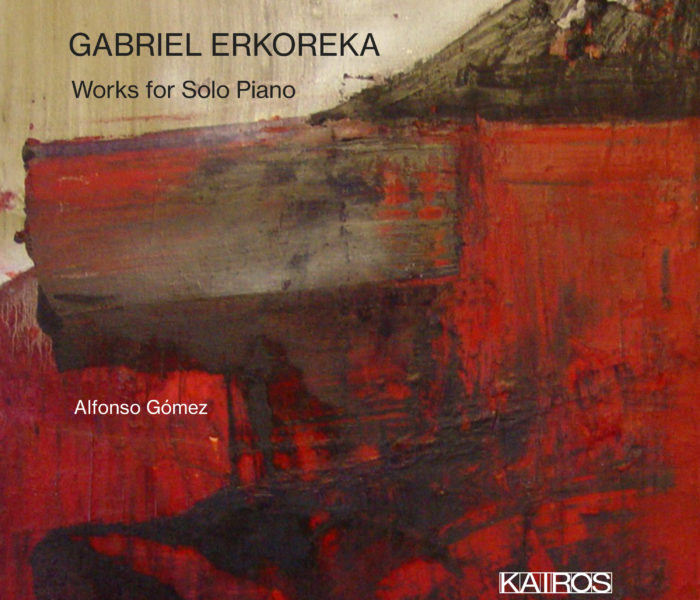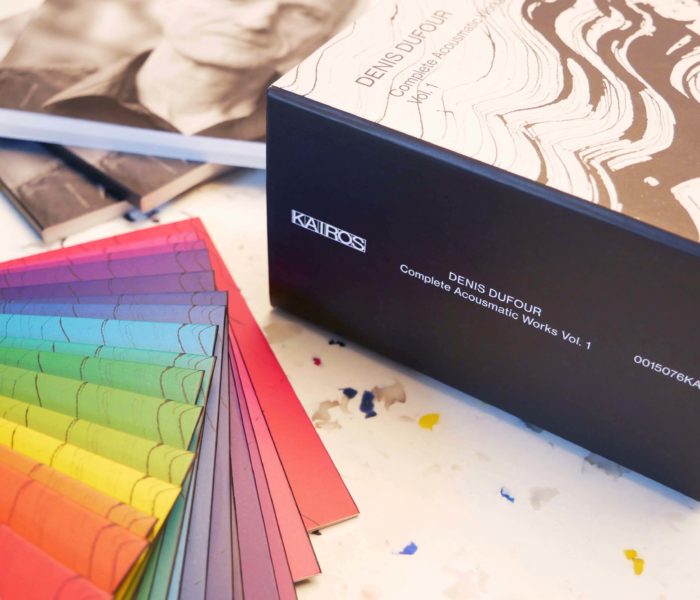Depuis plus de quarante ans, Denis Dufour est une personnalité incontournable de la musique de création. Compositeur extrêmement prolifique et grand expérimentateur, il affirme « écrire l’écoute plus que les sons ». On le connaît avant tout pour son travail dans le domaine de l’électroacoustique, en tant qu’héritier de l’école concrète de Pierre Schaeffer, aussi bien en musique acousmatique que mixte et live electronic, des notions que nous définirons dans cet éclairage. Mais Denis Dufour est également compositeur de musique acoustique instrumentale. Il aborde cette facette de son travail avec la même curiosité et le même amour de la matière sonore.
Deux sorties récentes nous offrent l’occasion de rencontrer le compositeur et de réaliser ce dossier : un livre d’entretiens avec Vincent Isnard paru au printemps 2021 chez Musica Falsa, La Composition de l’écoute, un ouvrage précieux qui retrace l’étendue de sa formation puis de son parcours musical, aborde ses méthodes de composition, les bases de son enseignement et met en perspective son art avec l’histoire de la musique concrète et des apports de Pierre Schaeffer ; et puis l’édition toute récente d’un coffret de seize CD par Maison ONA et le label Kairos, Complete Acousmatic Works Vol. 1, qui couvre la moitié de son œuvre acousmatique, soit quarante-quatre opus, dix-huit heures de musique !
C’est bien plus qu’il n’en faut pour lui consacrer une importante chronique dans le cadre de ce dossier. Nous interviewons par ailleurs Maxime Barthélemy, de Maison ONA, qui nous expose avec enthousiasme l’énergie qui porte ce très beau projet, qui peut sembler un peu fou en ces temps de disette pour l’industrie du disque, un projet d’ailleurs encore en cours, car cet impressionnant massif attend en effet déjà une suite : la parution de l’autre moitié des œuvres acousmatiques de Denis Dufour dans un deuxième coffret. Pour avoir une idée de l’ampleur de son œuvre, il faut y ajouter la même somme de pièces instrumentales, soit près de deux cents opus en tout.
Rappelons ici ce que signifie « musique acousmatique ». L’adjectif s’applique à un son que l’on entend sans voir la cause qui le produit. L’expérience de l’écoute de la radio est de cet ordre. L’auditeur essaye alors de deviner la source, ouvrant son écoute à l’imagination. Le concept vient de Pythagore, qui enseignait derrière une tenture à ses disciples au VIe siècle avant notre ère, afin d’éviter qu’ils se laissent distraire par ses mimiques et ses gestes. Pierre Schaeffer a utilisé le terme « acousmatique » pour définir l’écoute particulière suscitée par sa musique concrète, qui repose sur des sons enregistrés puis écoutés à travers le haut-parleur. Dans cette « musique concrète » qu’il a fait naître en 1948 avec ses Cinq études de bruit, le compositeur entend ce qu’il fait en même temps qu’il le fait, captant le son avec un microphone et travaillant directement sur cette matière, comme le peintre voit sa toile se réaliser au fur et à mesure. Cette démarche s’oppose à celle, abstraite, de la musique sur partition, où le compositeur imagine un résultat sonore avant de pouvoir l’entendre au travers de l’interprétation par des musiciens. Au moment des répétitions de l’œuvre, il doit d’ailleurs souvent effectuer des petites corrections a posteriori, travaillant alors sur le sonore concret.
Dans la musique concrète, les prises de son avec un microphone placé proche de la source sonore font qu’on ne reconnaît souvent plus du tout ce dont il s’agit à l’origine, Schaeffer parlant de cette source comme « anecdotique ». Même un « son anecdotique », dont on reconnaît clairement l’origine, peut perdre ce caractère une fois placé en rapport avec d’autres sons dans une composition concrète. En 1966, lorsqu’il publie son Traité des objets musicaux, une nouvelle grammaire musicale, un « solfège de l’objet sonore », Pierre Schaeffer hésite à le nommer « traité d’acousmatique ». Après ceux de « musique concrète » et de « musique électroacoustique », le terme de « musique acousmatique » s’impose. Cette musique possède ses règles de composition propres, comme Denis Dufour le souligne :
« L’écriture en acousmatique demande plus de temps parce qu’elle se pratique avec des sons très riches, qu’on appelle des “objets sonores” ou des “séquences”, qu’il va falloir maîtriser. Pierre Boulez affirmait d’ailleurs qu’on ne pouvait pas faire de la musique avec de tels sons, beaucoup trop complexes. Il revendiquait une musique abstraite faite avec des notes, qui sont en fait des simplifications du son, produites par des instruments qu’on a travaillés pendant des siècles afin de n’y entendre rien d’autre qu’elles. Tous les bruits, les frottements et les souffles y sont effacés. Il ne s’agit que d’une molécule de son avec ses paramètres bien séparés, hauteur, durée, intensité. La musique acousmatique travaille au contraire sur des sons dans toute leur richesse et leur complexité. »
Né à Lyon en 1953, Denis Dufour commence tard la musique, à quatorze ans, par l’étude du violon et de l’alto. Il entre au conservatoire de Lyon en 1972, puis au CNSMP (Conservatoire national supérieur de Paris) entre 1974 et 1979. Il y suit entre autres les cours d’Ivo Malec (composition), Pierre Schaeffer et Guy Reibel (électroacoustique) et Claude Baillif (analyse musicale). Malec, constatant que le jeune homme avait encore beaucoup à apprendre sur le métier de compositeur, lui conseille de s’inscrire d’abord en classe d’électroacoustique avec Reibel et Schaeffer. Le futur compositeur ne sait pas encore de quoi il s’agit, ne connaissant même pas le mot, mais il va se sentir immédiatement à son aise dans cet univers qui deviendra le sien. Il collabore alors avec l’Ina-GRM à partir de 1976, le Groupe de Recherches Musicales fondé en 1958 par Pierre Schaeffer, tout fraîchement intégré en 1975 à l’Institut national de l’audiovisuel. Cette collaboration se poursuit jusqu’en 2000. Ses premières compositions datent de la fin des années soixante-dix.
Dès 1977, le directeur du GRM François Bayle demande à Denis Dufour de cofonder le trio GRM avec Laurent Cuniot et Yann Geslin, qui deviendra l’ensemble TM+, un groupe de Live electronic music :
« Il y avait dans l’air cette idée d’expérimenter ce que l’on pouvait faire en direct avec des synthétiseurs, qui n’étaient alors pas très sophistiqués. […] Nous avons commencé avec des instruments encore monodiques, sans claviers, auxquels on accédait avec des boutons et des joysticks. On inventait une façon de jouer et de fixer afin de pouvoir reproduire : on ne faisait en effet pas de l’improvisation sur scène, même si on la pratiquait pour travailler et expérimenter à la source des morceaux. À partir d’elle, on réfléchissait à des compositions plus structurées. »
Compositeur, enseignant (aux conservatoires régionaux de Lyon et de Perpignan, au CNSM de Paris, au CRR de Paris et au pôle supérieur d’enseignement artistique de Paris Boulogne-Billancourt), Denis Dufour a également fondé, après TM+, les ensembles Les Temps modernes (1992) et Syntax (2004). Il participe à la création du Festival Futura à Crest en 1992, consacré à la musique acousmatique et aux arts de supports, qu’il dirige jusqu’en 2006. Il monte Motus en 1996, une structure d’édition, de production, de formation, d’organisation de concerts et d’événements.
Ce beau parcours devient plus impressionnant encore quand on apprend dans le livre d’entretiens de Vincent Isnard que le jeune Denis Dufour n’aimait pas du tout la musique contemporaine qu’il entendait en fréquentant régulièrement les concerts à Lyon. Découvrant à l’âge de seize ou dix-sept ans le fameux Thrène à la mémoire des victimes d’Hiroshima de Krzysztof Penderecki (1960), il trouve l’œuvre « très fumiste sur le moment, inintelligible », allant jusqu’à affirmer que « c’était vraiment du bruit, pour [lui] » (p. 13). Pourtant, un peu plus tard, il s’étonne de reconnaître la pièce à la radio et découvre alors qu’elle possède une forme identifiable, et donc un intérêt. Il nous confie : « C’est comme ça que j’ai compris que cette musique n’était pas n’importe quoi, qu’elle était digne d’écoute et que j’allais continuer ma démarche d’aller vers ces musiques que je ne connaissais pas encore. »
Parmi ses apports importants au monde de la musique, Denis Dufour participe, à partir des années 80, au développement du concept de l’acousmonium, cet orchestre de haut-parleurs fixé en 1973-1974 au GMEB (Groupe de musiques expérimentales de Bourges) et au GRM. L’idée germe dès 1952, lorsque Pierre Schaeffer et Jacques Poullin élaborent les premières bases de réflexion sur la projection du son et sa mise en espace. Le terme « acousmonium » est inventé par François Bayle en 1974, dérivé de « musique acousmatique ». Au départ, le dispositif est pensé de manière frontale, peu spatialisée, avec simplement deux haut-parleurs de rappel à l’arrière et sur les côtés, de moindre qualité, en imitation de l’orchestre, haut-parleurs aigus et graves étant imaginés comme des sons instrumentaux.
« Je suis arrivé dans cet univers au moment de la naissance de l’acousmonium. […] J’ai eu l’idée d’en faire un dispositif transportable au début des années quatre-vingt. Il était alors très lourd et très coûteux à déplacer. […] J’ai monté ma version de manière privée, pour ma classe à Lyon. Je l’ai fait évoluer en mettant des haut-parleurs partout, en le rendant totalement immersif. […] Un acousmonium peut compter jusqu’à quarante, cinquante ou même cent haut-parleurs. J’ai fait évoluer les réglages, pour que les potentiomètres de la console de projection soient cohérents avec le dispositif, et j’ai insisté sur l’importance de l’accorder aux lieux, pour supprimer les résonances parasites et les bourdonnements, et pour éviter les trous entre les enceintes lorsqu’on fait se déplacer un son. J’ai enseigné ensuite toutes ces techniques. Un de mes élèves, Jonathan Prager, est devenu un des plus grands interprètes de musique acousmatique. »
Ainsi, l’interprète doit connaître parfaitement les œuvres qu’il joue afin de pouvoir les spatialiser, en renforcer les contrastes, la dynamique, jouer sur les couleurs, sur la vitesse des sons, leur densité, et pouvoir s’adapter aux salles aussi bien qu’aux publics. Denis Dufour confie volontiers ses œuvres acousmatiques à des interprètes, car il estime qu’un compositeur n’est pas la personne la plus indiquée pour jouer ce rôle. Il voudra en effet tout faire entendre, au lieu de creuser les contrastes.
Contrairement à l’image que l’on se fait du travail solitaire de studio du compositeur d’électroacoustique, Denis Dufour travaille souvent en équipe et multiplie les collaborations. Sa musique acousmatique s’appuie par exemple très fréquemment sur des textes. Il s’associe régulièrement à Thomas Brando depuis 1986 (leur première collaboration date de 1981). Cet auteur, directeur artistique et graphiste a écrit et réalisé de nombreux projets que Denis Dufour a ensuite mis en musique à partir de ses textes et de ses intentions. On trouve aussi la présence d’Hamish Hossain, qui fut élève du compositeur, narrateur sur Les Cris de Tatibagan et chanteur en chant diphonique et en voix de gorge sur la Missa pro pueris. Cet environnement créatif est associé à un vaste travail de préparation : une patiente recherche de documentation et une longue maturation qui ont pour objectif de nourrir ses projets en profondeur. Denis Dufour reprend à son compte l’image du réalisateur, bénéficiant du talent de nombreux spécialistes autour de lui, qu’il coordonne pour mener son film à terme.
La musique acoustique écrite par Denis Dufour s’agence de la même manière que sa musique acousmatique, se fondant sur la pensée de la morphologie du son et l’écriture de l’écoute :
« Il faut composer la perception et non pas les notes, et même pas les sons. La perception est ce qui se passe dans la tête. On voit, on entend, on sent et on touche des choses par ce qui entre dans les oreilles. Quand je compose, il faut que je pense à ce que les gens vont ressentir tactilement, sonorement, visuellement et émotionnellement. »
Un bel exemple de cette facture se trouve dans la transcription de l’Étude aux sons animés de Pierre Schaeffer (1958) que Denis Dufour réécrit pour flûte, saxophone alto, clarinette basse, trompette, violoncelle dans Stèle pour Pierre Schaeffer (2013).
Infatigable, Denis Dufour, aujourd’hui à la retraite de ses activités d’enseignement, s’est installé avec son frère Hervé dans l’Abbaye de Lanvaux, en Bretagne, dans le Morbihan. Ils mènent actuellement des travaux sur ce site comprenant les ruines d’une abbaye cistercienne du XIIème siècle et une maison abbatiale du XVIIème siècle, en vue de les aménager en un lieu de création comprenant son propre studio et ses archives, une salle de concert et un lieu d’accueil pour des stages et des résidences artistiques autour de la musique, du chant, de la littérature et du yoga.
Guillaume Kosmicki
Vous pouvez écouter Denis Dufour au micro de Guillaume Kosmicki sur Radio Breizh dans une série de trois émissions (Emission 1, Emission 2, Emission 3)



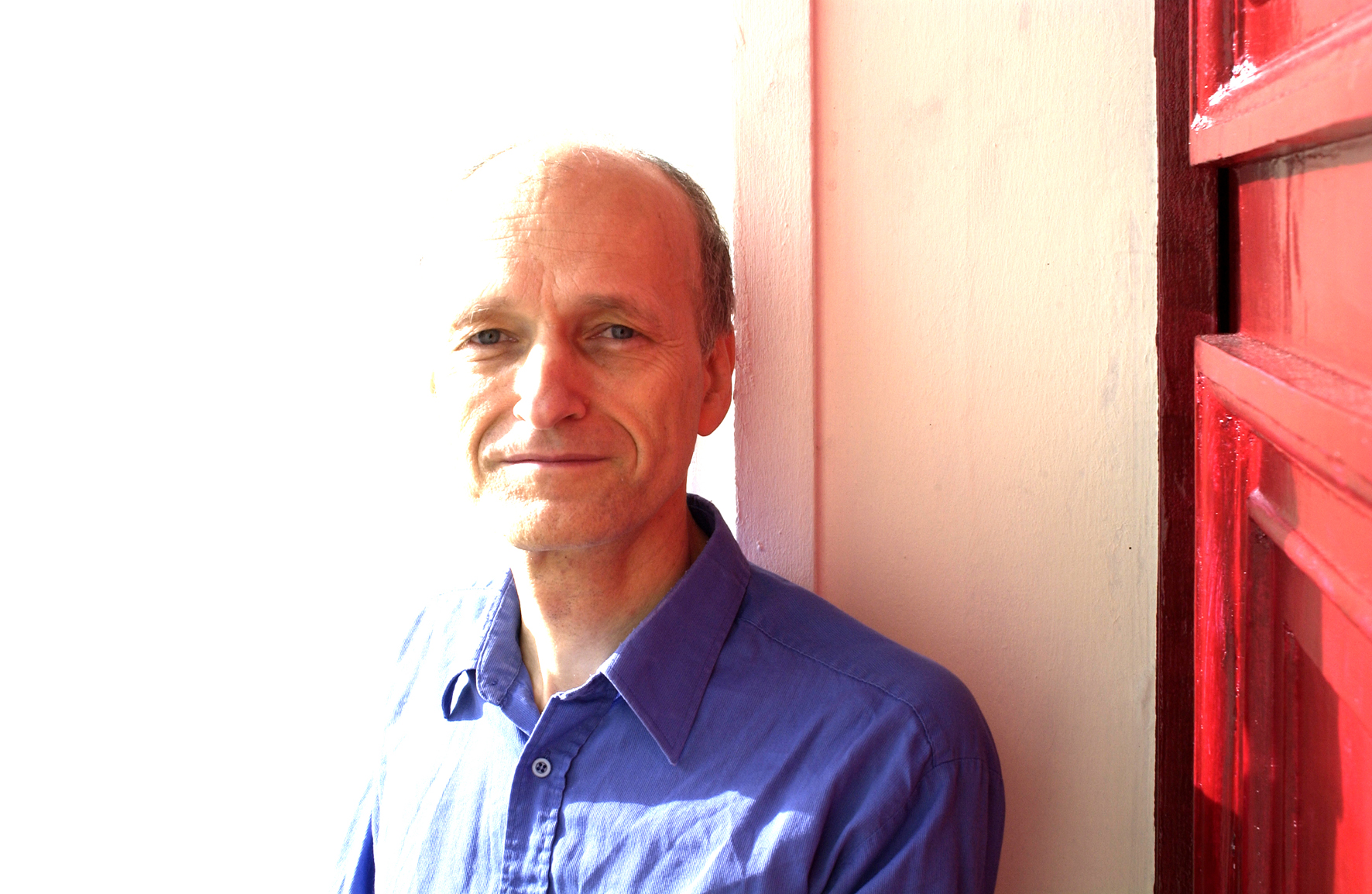)


